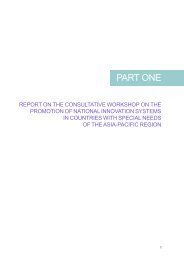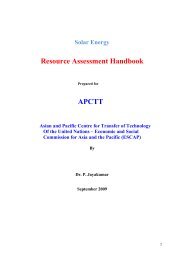the captive generation capacity) on 31 March 2012 was 231,393.90 MW. Electricitygeneration in the fiscal year 2011-12 was 876.88 billion units. The national annual percapita consumption of electricity during the same period was 813.3 kWh.The approach paper to the 12 th FYP, Mr. Chaturvedi pointed out, has focused on additionto the power generation capacity in the country during the period 2012-2017. Theexpected addition is 94,000 MW. 6 Coal- and gas-based power plants are expected toadd 63,781 MW, hydro projects 9,200 MW and nuclear power 2,800 MW. Renewableenergy sources are expected to add about 29,000 MW during the period. The powersector would require an investment of nearly Rs 13,726 billion (about US$269.80 billion),including Rs 1,351 billion (US$26.60 billion) for renewable energy during 2012-2017,and the private sector is expected to invest 50 per cent this.Automatic approval (Reserve Bank of India Rule) is provided for 100 per cent foreignequity in generation, transmission, distribution and trading of power without any uppersealing on the quantum of investment. FDI in the power sector in the fiscal year 2010-11 was US$1,252 million, making it to a cumulative of US$5,900 million since 1 April2000.The 12 th FYP Working Group has recommended funding of R&D programmes throughvarious schemes such as the National Perspective Plan (NPP) and the ResearchScheme on Power (RSoP). The financial requirement to execute such projects is Rs15 billion (US$294.87 million). A National Clean Energy Fund (NCEF) has been createdfor funding research and innovative projects in clean energy technology. The corpusunder the fund in the fiscal year 2011-12 is expected to be Rs 65 billion (US$1.28billion).CCT development is considered appropriate for the following technologies: refineryresidue-based IGCC; imported coal-based IGCC; high-efficiency CCGT; indigenouscoal-based IGCC; normal CCGT; ultra-supercritical boiler; and supercritical boiler. Thesetechnologies could result in reducing coal consumption by 122 million tonnes of oilequivalent by 2031.The major conclusions of the baseline report are:• Coal will remain an important primary source of energy;• Investment mobilization would be feasible if a GDP growth rate of 8 per cent ismaintained;• Investment in the power generation sector offers an opportunity for the business;• FDI needs to be attracted and the business needs to play an important role;• Fund support for R&D should be enhanced; and• Policy for R&D fund utilization from coal cess and other such routes needs to beestablished.In his presentation on “Financing of the Power Sector”, Mr. S.V. Prasad cited theinvolvement of SBI Capital Markets Limited (SBI Caps) with government’s variouscommittees under the Ministry of Power and the Planning Commission to advise onbroad policy issues and financing aspects of the power sector (Annex XII). SBI Caps,6See footnote 2 on page 5 regarding variation in figures.22
incorporated in 1986 as a wholly owned subsidiary of State Bank of India, has arrangedaggregate debt of Rs 1,392.7 billion (US$28 billion) for the power sector for about25,000 MW generation capacity during 2010 and 2011. It has funded projects in bothpublic and private sectors.Financial help of the off-takers is a major concern mainly due to: precarious financialhelp and negative worth of power distribution companies (Discoms); widening gapbetween average revenue realization (ARR) and average cost of supply (ACS); andestimated accumulated losses of Discoms at Rs 1,200 billion (US$23.6 billion). Fearabout the financial restructuring of many power projects owing to delays has beenanother major concern. Difficulties in timely execution are caused by issues related toland acquisition, firm power purchase agreements (PPAs)/off-take arrangement, fuelsupply and transportation arrangements, transportation network, and time taken forgovernment clearances and evacuation arrangement (which are sometimes beyondthe developer’s control).Certain constraints have surfaced in the current lending scenario: aggressive lendingto extremely selective cases; power sector lending being close to saturation; increasingdemand for higher upfront equity; significant hardening of interest rates in the pastthree years; lenders’ preference for short loan tenures, which are especially inadequatefor hydro and renewable sectors; lenders’ demand for greater recourse, other thanproject assets; and slowing down of power sector investments. In such a situation, theonly feasible way forward is to adopt measures such as: improvement in the financialperformance of Discoms; stepping up of coal mining; expediting implementation ofdedicated freight corridor; close monitoring of projects and government interventionwherever needed to sort out matters; expediting forest and environmental clearancesand coal linkages by government; and facilitation of take-out finances (proposed in thebudget for the fiscal year 2011-12).Mr. Subhranshu Patnaik’s presentation dealt with “Advanced Fossil Fuel-based PowerGeneration: Financing Challenges” (Annex XIII). Major power projects are being establishedthrough competitive bidding route, and the electricity tariff is to be decided bythe Central Electricity Regulatory Commission (CERC) and the State ElectricityRegulatory Commissions (SERCs). However, these regulatory commissions have beenhesitant to revise electricity tariffs in a timely fashion. Some of the states have notrevised tariffs for almost 7-8 years. State utility companies are dependent on subsidyfor their finances and their financial health is deteriorating because of reducing revenues.As at the end of financial year 2009-10, all state utilities together have made a loss ofabout Rs 820 billion (US$16.12 billion). The five states of Maharashtra, Madhya Pradesh,Rajasthan, Tamil Nadu and Uttar Pradesh contributed 75 per cent of the total losses inthe financial year 2009-10, while contributing only 40 per cent of the total sales. Morethan 70 per cent of the losses were financed by public sector banks. Kerala, Chattisgarhand Delhi continued to make some profits.Competition for coal assets are heating up and increasingly, the quality of such assetsavailable in the market is going down, as only the low-hanging fruits are being harvested.Banks and Infrastructure Finance Companies (IFCs) account for about 85 per cent ofthe total loans to the power sector with banks being the primary sources of funds forprivate borrowers. The total amount of loan outstanding against the power sector isestimated at Rs 6,500 billion (US$127.78 billion), with banks accounting for approximately46.1 per cent, IFCs about 38.5 per cent, and government lending through grants23
- Page 1 and 2: ADVANCES IN FOSSIL FUELTECHNOLOGIES
- Page 3 and 4: ADVANCES IN FOSSIL FUELTECHNOLOGIES
- Page 5 and 6: CONTENTSABBREVIATIONSiiiPART ONEREP
- Page 7 and 8: ABBREVIATIONSAC : Alternating curre
- Page 9: OECD : Organization for Economic Co
- Page 12 and 13: IORGANIZATION OF THE WORKSHOPA. Bac
- Page 14 and 15: D. Election of officersThe followin
- Page 16 and 17: IIICONSIDERATION OF ISSUESA. Backgr
- Page 18 and 19: emissions. Underground coal gasific
- Page 20 and 21: 800 MWe, a steam pressure of 300 kg
- Page 22 and 23: • Materials development & manufac
- Page 24 and 25: Figure 1-5: Strategy for commercial
- Page 26 and 27: tonnes, the state-owned enterprise
- Page 28 and 29: • Ensuring not just easy FDI entr
- Page 30 and 31: MW ultra-supercritical units; and s
- Page 34 and 35: and other financial institutions -
- Page 36 and 37: and higher efficiency power generat
- Page 38 and 39: energy technologies, which can enab
- Page 40 and 41: • Such massive financial inputs c
- Page 43 and 44: BASELINE REPORT ON FOSSIL FUEL TECH
- Page 45 and 46: B. General R&D climate in the count
- Page 47 and 48: a convenient way to envisage energy
- Page 49 and 50: to mature and become more cost-comp
- Page 51 and 52: emissions, at least relative to sin
- Page 53 and 54: The Ministry of Power (MoP), which
- Page 55 and 56: 3. Bio-energyBio-energy, widely ava
- Page 57 and 58: in such a canal will rotate at a lo
- Page 59 and 60: in tackling climate change. A one p
- Page 61 and 62: Advantages of supercritical plants
- Page 63 and 64: existing power plants but also to b
- Page 65 and 66: BASELINE REPORT ON FOREIGN DIRECT I
- Page 67 and 68: CEA at 598 mt. This is mainly due t
- Page 69 and 70: For India to maintain its momentum
- Page 71 and 72: Table 2-5: Electricity generation t
- Page 73 and 74: Growth, which submitted its interim
- Page 75 and 76: 3. Future challengesThe future chal
- Page 77 and 78: development worked out. Public-priv
- Page 79 and 80: Linking FDI to technology transferI
- Page 81 and 82: The total requirement of fund durin
- Page 83 and 84:
Funding from multilateral agenciesM
- Page 85 and 86:
cooperation will be essential in so
- Page 87:
Planning Commission, Government of
- Page 90 and 91:
ANNEX I:LIST OF PARTICIPANTSMr. A.K
- Page 92 and 93:
Mr. S.C. Shrivastava, Joint Chief (
- Page 94 and 95:
ANNEX II:PROGRAMME6 June 2012, Wedn
- Page 96 and 97:
ANNEX III:AN OVERVIEW OF ADVANCED F
- Page 98 and 99:
• Technology solutions are also v
- Page 100 and 101:
Table 3-5: Improvement in cycle eff
- Page 102 and 103:
• No liquid effluent formation;
- Page 104 and 105:
Figure 3-5: Advancement of gas turb
- Page 106 and 107:
Figure 3-8: Goal 2 - New clean tech
- Page 108 and 109:
Compared with conventional power pl
- Page 110 and 111:
Figure 3-14: Thermax coal gasificat
- Page 112 and 113:
ANNEX VII:GE ENERGY AND ADVANCED FO
- Page 114 and 115:
ANNEX VIII:SWOT ANALYSIS OF FOSSIL
- Page 116 and 117:
By 2035, cumulative CO 2emissions f
- Page 118 and 119:
• Falling prices of renewable ene
- Page 120 and 121:
Figure 3-20: New advanced coal powe
- Page 122 and 123:
ANNEX X:ENERGY CONSERVATION: ERDA
- Page 124 and 125:
Table 3-11: Energy cost and intensi
- Page 126 and 127:
300Figure 3-23: Trends in coal use
- Page 128 and 129:
C. Gaps in coal use efficiencyFigur
- Page 130 and 131:
ANNEX XII:FINANCING OF THE POWER SE
- Page 132 and 133:
With the entry of many private sect
- Page 134 and 135:
for future requirements should be t
- Page 136 and 137:
Short supply of coal has started af
- Page 138:
Figure 3-35: Life-cycle of technolo







